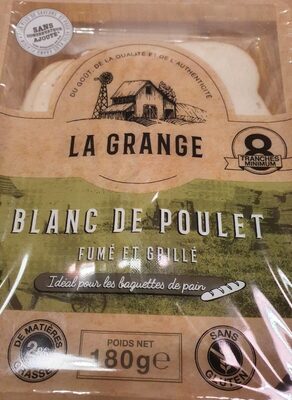Blanc de poulet fumé et grillé - La Grange - 180 g
This product page is not complete. You can help to complete it by editing it and adding more data from the photos we have, or by taking more photos using the app for Android or iPhone/iPad. Thank you!
×
Barcode: 7290001567524 (EAN / EAN-13)
Quantity: 180 g
Brands: La Grange
Categories: Meats and their products, Prepared meats, fr:Charcuteries cuites, Poultry hams, Cooked chicken breast slices
Labels, certifications, awards: Kosher, No preservatives
Countries where sold: France
Matching with your preferences
Environment
Carbon footprint
Packaging
Transportation
Report a problem
Data sources
Product added on by kiliweb
Last edit of product page on by roboto-app.
Product page also edited by autorotate-bot, desan, moon-rabbit, openfoodfacts-contributors, org-app-foodbowel, sebleouf, tacite-mass-editor, yuka.R293aUxwa3FyT0JSeGNkaXp6cit3WXBhbnJHUFZEdUxKTUF5SVE9PQ, yuka.sY2b0xO6T85zoF3NwEKvlk5EV_6GsiDDHkXmxmevw9fXMsGzMYlY0NDDGao, yuka.sY2b0xO6T85zoF3NwEKvlk5Yc_6D-GnaaTvtm2HamsqiE6XDf99t4tThLas, yuka.sY2b0xO6T85zoF3NwEKvlkpGXfH_iRj4agzimUmXm--BNLnuYNNvxrHVKKs.










